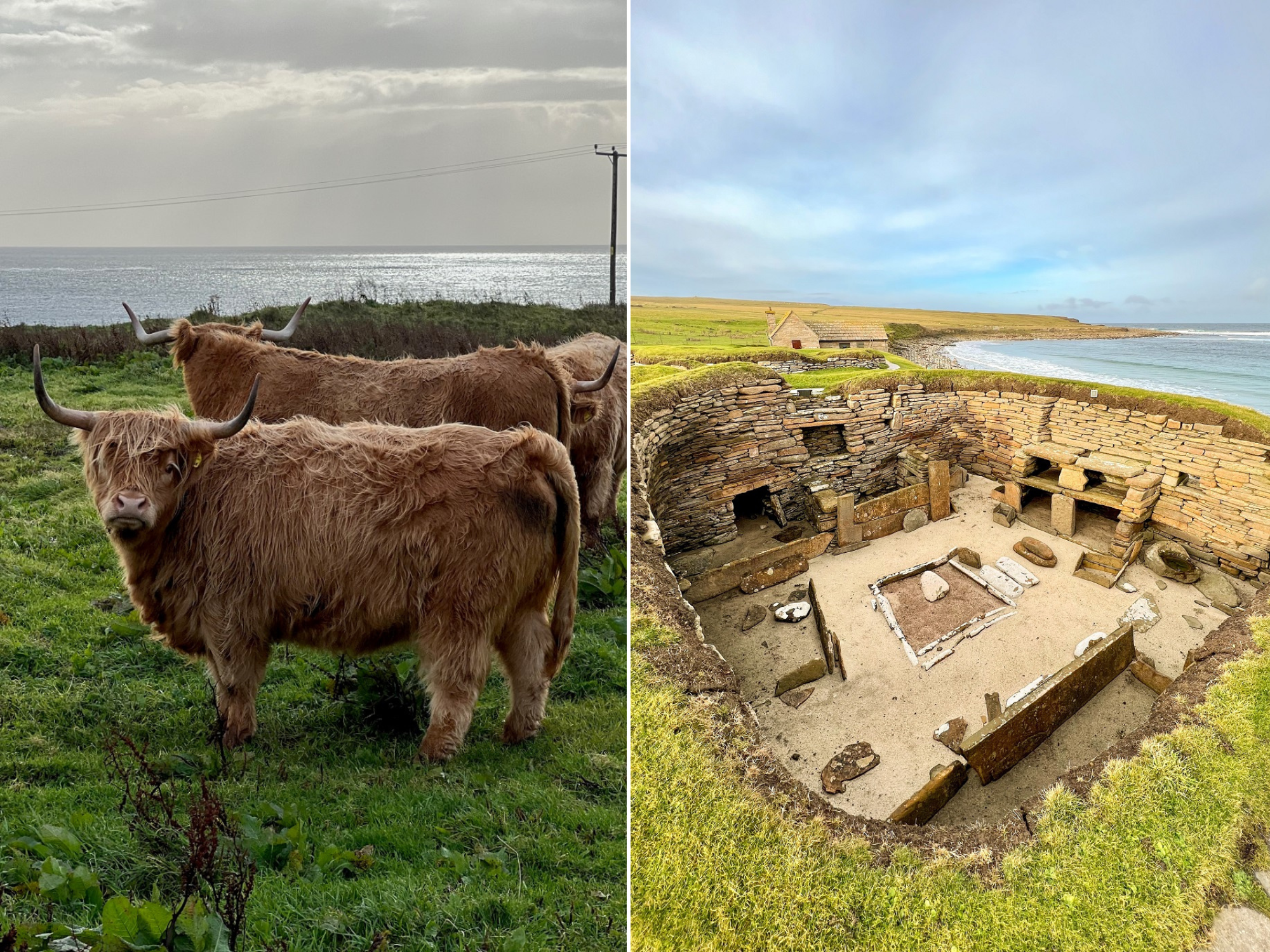The gale-force wind bears down from the North Sea, buffeting my Gore-Tex-clad body like a giant hand threatening to push me off my feet. Planting hiking poles deeper into the boggy heather, I brace myself to absorb the squall as it arrives howling with horizontal rain that hits my face like a shower of piercing needles.
"It’s blowin’ a hoolie,” shouts my guide Will Snow over the roar. Translated from Orcadian, a hoolie is a fearsome gale wind. It’s on point. My Wilderness Scotland group struggles to get back on track, hiking along the cliffs of Mull Head on Mainland, the largest of Orkney’s 20 inhabited islands.
 Claudia Laroye
Claudia Laroye
The people living in the Orkney Archipelago, one hour ferry ride north of the Scottish Mainland, have a generous vocabulary for rain and weather. Like the Inuit in Canada’s North, Orcadians and Scots have a deep respect for and many colourful phrases to describe the elements that have shaped the landscape and human habitation here over thousands of years.
The Orkney Islands are remote and isolated, which is part of their attraction for visitors, along with a unique history and landscape once inhabited by Vikings. Norse roots run deep here: people spoke Norn, an Orkney dialect instead of Gaelic, and the Orcadian flag includes the colours of the Norwegian coat of arms.
For many travellers, the trip north of Scotland’s northern coast is a rewarding journey back in time. Orkney is home to the UNESCO Heart of Neolithic Orkney World Heritage Site, consisting of extraordinary historical places dating back 5,000 years.
 Claudia Laroye | Skara Brae
Claudia Laroye | Skara Brae
Orkney’s four Neolithic sites are home to some of the oldest human settlements in the world. Long before the Vikings made contact in the eighth century, stone villages flourished, people cultivated the land and built cairns and rings of standing stones whose meaning is now lost to history.
One of these, the Ring of Brodgar, is the largest in Scotland and older than its famous cousin, Stonehenge. According to native-born Orcadian and Historic Scotland guide Elaine Clarke, the Ring and its 60 original stones are the work of an advanced society, but its purpose remains a mystery to this day. Whether The Ring was made for religious celebrations, community gatherings or to honour the solstice, no one really knows. Clarke notes wryly that, "The Ring can mean whatever you want it to mean."
 Claudia Laroye | Ring of Brodgar
Claudia Laroye | Ring of Brodgar
Brodgar is one of four major Neolithic monuments that make up Orkney’s World Heritage Site, a "cradle to grave experience of the Neolithic" that travellers can easily explore at their leisure between hikes along rolling hills covered in yellow heather and walks to natural wonders like the Cliffs of St. John’s Head, the highest vertical sea cliffs in Orkney.
 Claudia Laroye | Cliffs of St. John’s Head
Claudia Laroye | Cliffs of St. John’s Head
Orkney’s other UNESCO sites include Skara Brae settlement, the Stones of Stenness and the Maes Howe Chambered Cairn. On my tour, guide George Howe shares what the uses of the Cairn might have been – burial mound, shelter, solstice hall? Howe points to ancient rune graffiti etched into the walls by stranded Vikings who took shelter here. The translated runes complain about the decline in the hardiness of 11th century Viking youth. It seems some things never change.
Cultural and historical appreciation draws curious travellers to the friendly Orkneys, but so does the opportunity for adventure on its islands, reachable via World War II-era “Churchill barrier” causeways or convenient inter-island ferries.
I board just such a ferry for a short 30-minute trip to the island of Hoy, where there appears to be more sheep than humans. The uphill hike to the Old Man of Hoy takes me along vertigo-inducing cliffs with limitless views of the North Atlantic.
The Old Man formation was once two-legged but is now a singular sea-stack of red sandstone, a solitary obelisk enduring the constant crash of stormy Atlantic waves. My visit coincides with a "braw (good) day" of sunshine and no wind. After nearly being blown off a cliff a few days ago, I’ll take it.
 Claudia Laroye | Old Man of Hoy
Claudia Laroye | Old Man of Hoy
The break is short-lived, however. The next day dawns with what my waitress at the Lynnfield Hotel in Orkney’s largest city Kirkwall, declares will be a "six (laundry) peg day," Orcadian for "very windy." Her sheets are pegged, and I’m decked out in full waterproof gear, ready for my hike to Yesnaby.
 Claudia Laroye | "The Castle"
Claudia Laroye | "The Castle"
The six kilometre walk along the rugged western coastline starts well enough. I hike towards the sea stack known as the "Castle," which looks ready to collapse into ruin with the next rogue wave. Within minutes, the smir (light drizzle) is turning into a raging hellafa dreich (dreary downpour). Cameras quickly disappear into backpacks.
Despite the torrents of rain and gusts of wind, I start laughing. The physical reality of Orcadian weather is something to behold. And there’s nothing as exhilarating or rewarding as braving these impressive elements while exploring the astonishing Orkney Islands.
Note: The author was hosted by Wilderness Scotland. Her opinions are her own.


